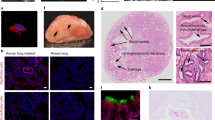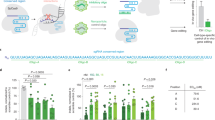Abstract
Specific and efficient gene delivery to the lung has been hampered by liver sequestration of adenovirus serotype 5 (Ad5) vectors. The complexity of Ad5 liver tropism has largely been unraveled, permitting improved efficacy of Ad5 gene delivery. However, Kupffer cell (KC) scavenging and elimination of Ad5 still represent major obstacles to lung gene delivery strategies. KC uptake substantially reduces bioavailability of Ad5 for target tissues and compensatory dose escalation leads to acute hepatotoxicity and a potent innate immune response. Here, we report a novel lung-targeting strategy through redirection of Ad5 binding to the concentrated leukocyte pool within the pulmonary microvasculature. We demonstrate that this leukocyte-binding approach retargets Ad5 specifically to lung endothelial cells and prevents KC uptake and hepatocyte transduction, resulting in 165 000-fold enhanced lung targeting, compared with Ad5. In addition, myeloid cell-specific binding is preserved in single-cell lung suspensions and only Ad.MBP-coated myeloid cells achieved efficient endothelial cell transduction ex vivo. These findings demonstrate that KC sequestration of Ad5 can be prevented through more efficient uptake of virions in target tissues and suggest that endothelial transduction is achieved by leukocyte-mediated ‘hand-off’ of Ad.
This is a preview of subscription content, access via your institution
Access options
Subscribe to this journal
Receive 12 print issues and online access
$259.00 per year
only $21.58 per issue
Buy this article
- Purchase on Springer Link
- Instant access to full article PDF
Prices may be subject to local taxes which are calculated during checkout






Similar content being viewed by others
References
Raper SE, Chirmule N, Lee FS, Wivel NA, Bagg A, Gao GP et al. Fatal systemic inflammatory response syndrome in a ornithine transcarbamylase deficient patient following adenoviral gene transfer. Mol Genet Metab 2003; 80: 148–158.
Hacein-Bey-Abina S, Hauer J, Lim A, Picard C, Wang GP, Berry CC et al. Efficacy of gene therapy for X-linked severe combined immunodeficiency. N Engl J Med 2010; 363: 355–364.
Cideciyan AV, Hauswirth WW, Aleman TS, Kaushal S, Schwartz SB, Boye SL et al. Vision 1 year after gene therapy for Leber’s congenital amaurosis. N Engl J Med 2009; 361: 725–727.
Parker AL, Nicklin SA, Baker AH . Interactions of adenovirus vectors with blood: implications for intravascular gene therapy applications. Curr Opin Mol Ther 2008; 10: 439–448.
Descamps D, Benihoud K . Two key challenges for effective adenovirus-mediated liver gene therapy: innate immune responses and hepatocyte-specific transduction. Curr Gene Ther 2009; 9: 115–127.
Lieber A, He CY, Meuse L, Schowalter D, Kirillova I, Winther B et al. The role of Kupffer cell activation and viral gene expression in early liver toxicity after infusion of recombinant adenovirus vectors. J Virol 1997; 71: 8798–8807.
Tao N, Gao GP, Parr M, Johnston J, Baradet T, Wilson JM et al. Sequestration of adenoviral vector by Kupffer cells leads to a nonlinear dose response of transduction in liver. Mol Ther 2001; 3: 28–35.
Worgall S, Wolff G, Falck-Pedersen E, Crystal RG . Innate immune mechanisms dominate elimination of adenoviral vectors following in vivo administration. Hum Gene Therapy 1997; 8: 37–44.
Xu Z, Tian J, Smith JS, Byrnes AP . Clearance of adenovirus by Kupffer cells is mediated by scavenger receptors, natural antibodies, and complement. J Virol 2008; 82: 11705–11713.
Sharma A, Bangari DS, Tandon M, Hogenesch H, Mittal SK . Evaluation of innate immunity and vector toxicity following inoculation of bovine, porcine or human adenoviral vectors in a mouse model. Virus Res 2010; 153: 134–142.
Zhang Y, Chirmule N, Gao GP, Qian R, Croyle M, Joshi B et al. Acute cytokine response to systemic adenoviral vectors in mice is mediated by dendritic cells and macrophages. Mol Ther 2001; 3 (Part 1): 697–707.
Doronin K, Flatt JW, Di Paolo NC, Khare R, Kalyuzhniy O, Acchione M et al. Coagulation factor X activates innate immunity to human species C adenovirus. Science 2012, (e-pub ahead of print 27 September 2012; doi:10.1126/science.1226625).
Shayakhmetov DM, Gaggar A, Ni S, Li ZY, Lieber A . Adenovirus binding to blood factors results in liver cell infection and hepatotoxicity. J Virol 2005; 79: 7478–7491.
Parker AL, Waddington SN, Nicol CG, Shayakhmetov DM, Buckley SM, Denby L et al. Multiple vitamin K-dependent coagulation zymogens promote adenovirus-mediated gene delivery to hepatocytes. Blood 2006; 108: 2554–2561.
Waddington SN, McVey JH, Bhella D, Parker AL, Barker K, Atoda H et al. Adenovirus serotype 5 hexon mediates liver gene transfer. Cell 2008; 132: 397–409.
Di Paolo NC, van Rooijen N, Shayakhmetov DM . Redundant and synergistic mechanisms control the sequestration of blood-borne adenovirus in the liver. Mol Ther 2009; 17: 675–684.
Ganesan LP, Mohanty S, Kim J, Clark KR, Robinson JM, Anderson CL . Rapid and efficient clearance of blood-borne virus by liver sinusoidal endothelium. PLoS Pathog 2011; 7: e1002281.
Di Paolo NC, Shayakhmetov DM . Adenovirus de-targeting from the liver. Curr Opin Mol Ther 2009; 11: 523–531.
Krasnykh VN, Douglas JT, van Beusechem VW . Genetic targeting of adenoviral vectors. Mol Ther 2000; 1 (Part 1): 391–405.
Waehler R, Russell SJ, Curiel DT . Engineering targeted viral vectors for gene therapy. Nat Rev Genet 2007; 8: 573–587.
Sharma A, Li X, Bangari DS, Mittal SK . Adenovirus receptors and their implications in gene delivery. Virus Res 2009; 143: 184–194.
Pickles RJ . Physical and biological barriers to viral vector-mediated delivery of genes to the airway epithelium. Proc Am Thorac Soc 2004; 1: 302–308.
Reynolds PN, Zinn KR, Gavrilyuk VD, Balyasnikova IV, Rogers BE, Buchsbaum DJ et al. A targetable, injectable adenoviral vector for selective gene delivery to pulmonary endothelium in vivo. Mol Ther 2000; 2: 562–578.
Everts M, Kim-Park SA, Preuss MA, Passineau MJ, Glasgow JN, Pereboev AV et al. Selective induction of tumor-associated antigens in murine pulmonary vasculature using double-targeted adenoviral vectors. Gene Therapy 2005; 12: 1042–1048.
Kalyuzhniy O, Di Paolo NC, Silvestry M, Hofherr SE, Barry MA, Stewart PL et al. Adenovirus serotype 5 hexon is critical for virus infection of hepatocytes in vivo. Proc Natl Acad Sci USA 2008; 105: 5483–5488.
Vigant F, Descamps D, Jullienne B, Esselin S, Connault E, Opolon P et al. Substitution of hexon hypervariable region 5 of adenovirus serotype 5 abrogates blood factor binding and limits gene transfer to liver. Mol Ther 2008; 16: 1474–1480.
Alba R, Bradshaw AC, Parker AL, Bhella D, Waddington SN, Nicklin SA et al. Identification of coagulation factor (F)X binding sites on the adenovirus serotype 5 hexon: effect of mutagenesis on FX interactions and gene transfer. Blood 2009; 114: 965–971.
Alba R, Bradshaw AC, Coughlan L, Denby L, McDonald RA, Waddington SN et al. Biodistribution and retargeting of FX-binding ablated adenovirus serotype 5 vectors. Blood 2010; 116: 2656–2664.
Reynolds PN, Nicklin SA, Kaliberova L, Boatman BG, Grizzle WE, Balyasnikova IV et al. Combined transductional and transcriptional targeting improves the specificity of transgene expression in vivo. Nat Biotechnol 2001; 19: 838–842.
Wiggs BR, English D, Quinlan WM, Doyle NA, Hogg JC, Doerschuk CM . Contributions of capillary pathway size and neutrophil deformability to neutrophil transit through rabbit lungs. J Appl Physiol 1994; 77: 463–470.
Kuebler WM, Goetz AE . The marginated pool. Eur Surg Res 2002; 34: 92–100.
Sallenave JM, Porteous DJ, Haslett C . Gene therapy for lung inflammatory diseases: not so far away? Thorax 1997; 52: 742–744.
Alberti MO, Roth JC, Ismail M, Tsurata Y, Abraham E, Pereboeva L et al. Derivation of a myeloid cell-binding adenovirus for gene therapy of inflammation. PLoS One 2012; 7: e37812.
Doerschuk CM, Downey GP, Doherty DE, English D, Gie RP, Ohgami M et al. Leukocyte and platelet margination within microvasculature of rabbit lungs. J Appl Physiol 1990; 68: 1956–1961.
Izumi M, Kawakami Y, Glasgow JN, Belousova N, Everts M, Kim-Park S et al. In vivo analysis of a genetically modified adenoviral vector targeted to human CD40 using a novel transient transgenic model. J Gene Med 2005; 7: 1517–1525.
Alemany R, Curiel DT . CAR-binding ablation does not change biodistribution and toxicity of adenoviral vectors. Gene Therapy 2001; 8: 1347–1353.
Frank DB, Abtahi A, Yamaguchi DJ, Manning S, Shyr Y, Pozzi A et al. Bone morphogenetic protein 4 promotes pulmonary vascular remodeling in hypoxic pulmonary hypertension. Circ Res 2005; 97: 496–504.
Khare R, May SM, Vetrini F, Weaver EA, Palmer D, Rosewell A et al. Generation of a Kupffer cell-evading adenovirus for systemic and liver-directed gene transfer. Mol Ther 2011; 19: 1254–1262.
Corjon S, Gonzalez G, Henning P, Grichine A, Lindholm L, Boulanger P et al. Cell entry and trafficking of human adenovirus bound to blood factor X is determined by the fiber serotype and not hexon:heparan sulfate interaction. PLoS One 2011; 6: e18205.
Johnson M, Huyn S, Burton J, Sato M, Wu L . Differential biodistribution of adenoviral vector in vivo as monitored by bioluminescence imaging and quantitative polymerase chain reaction. Hum Gene Ther 2006; 17: 1262–1269.
Roth JC, Curiel DT, Pereboeva L . Cell vehicle targeting strategies. Gene Therapy 2008; 15: 716–729.
Cole C, Qiao J, Kottke T, Diaz RM, Ahmed A, Sanchez-Perez L et al. Tumor-targeted, systemic delivery of therapeutic viral vectors using hitchhiking on antigen-specific T cells. Nat Med 2005; 11: 1073–1081.
Tallone T, Malin S, Samuelsson A, Wilbertz J, Miyahara M, Okamoto K et al. A mouse model for adenovirus gene delivery. Proc Natl Acad Sci USA 2001; 98: 7910–7915.
Noureddini SC, Krendelshchikov A, Simonenko V, Hedley SJ, Douglas JT, Curiel DT et al. Generation and selection of targeted adenoviruses embodying optimized vector properties. Virus Res 2006; 116: 185–195.
Maizel JV, White DO, Scharff MD . The polypeptides of adenovirus. I. Evidence for multiple protein components in the virion and a comparison of types 2, 7A, and 12. Virology 1968; 36: 115–125.
Douglas JT, Miller CR, Kim M, Dmitriev I, Mikheeva G, Krasnykh V et al. A system for the propagation of adenoviral vectors with genetically modified receptor specificities. Nat Biotechnol 1999; 17: 470–475.
Reynolds P, Dmitriev I, Curiel D . Insertion of an RGD motif into the HI loop of adenovirus fiber protein alters the distribution of transgene expression of the systemically administered vector. Gene Therapy 1999; 6: 1336–1339.
Davies LA, Varathalingam A, Painter H, Lawton AE, Sumner-Jones SG, Nunez-Alonso GA et al. Adenovirus-mediated in utero expression of CFTR does not improve survival of CFTR knockout mice. Mol Ther 2008; 16: 812–818.
Acknowledgements
This research was supported by NIH Grants R42CA114921 and R01HL092941 to DTC and the Gene Therapy Center at UAB. MOA was supported in part by a training grant to the UAB Medical Scientist Training Program (NIH T32GM008361). JCR was supported in part by the training grant NIH T32CA075930 and by a grant from the Kaul Pediatric Research Institute. We would like to acknowledge all of the following people at UAB: the laboratories of Richard J Whitley and James M Markert for valuable support; Louis B Justement and Namasivayam Ambalavanan for key reagents; Pamela Powell, Dezhi Wang, Gene Seigel and the Comparative Pathology Laboratory for assistance with IHC; Kimberly Thomas, Robert Snelgrove, David Gaston and Brian Dizon for technical assistance; members of the Curiel lab, including Igor Dmitriev, Elena Kashentseva, Hideyo Ugai, Alexander Pereboev, Svetlana Komarova, Meredith Preuss and Joel Glasgow for valuable support and helpful discussions. We are also indebted to Marion Spell for assistance with FACS and J Edwin Blalock, Amit Gaggar and Dennis Revie for critical review of the manuscript.
Author information
Authors and Affiliations
Corresponding authors
Ethics declarations
Competing interests
The authors declare no conflict of interest.
Additional information
Supplementary Information accompanies the paper on Gene Therapy website
Supplementary information
Rights and permissions
About this article
Cite this article
Alberti, M., Deshane, J., Chaplin, D. et al. A myeloid cell-binding adenovirus efficiently targets gene transfer to the lung and escapes liver tropism. Gene Ther 20, 733–741 (2013). https://doi.org/10.1038/gt.2012.91
Received:
Revised:
Accepted:
Published:
Issue Date:
DOI: https://doi.org/10.1038/gt.2012.91
Keywords
This article is cited by
-
The myeloid-binding peptide adenoviral vector enables multi-organ vascular endothelial gene targeting
Laboratory Investigation (2014)



